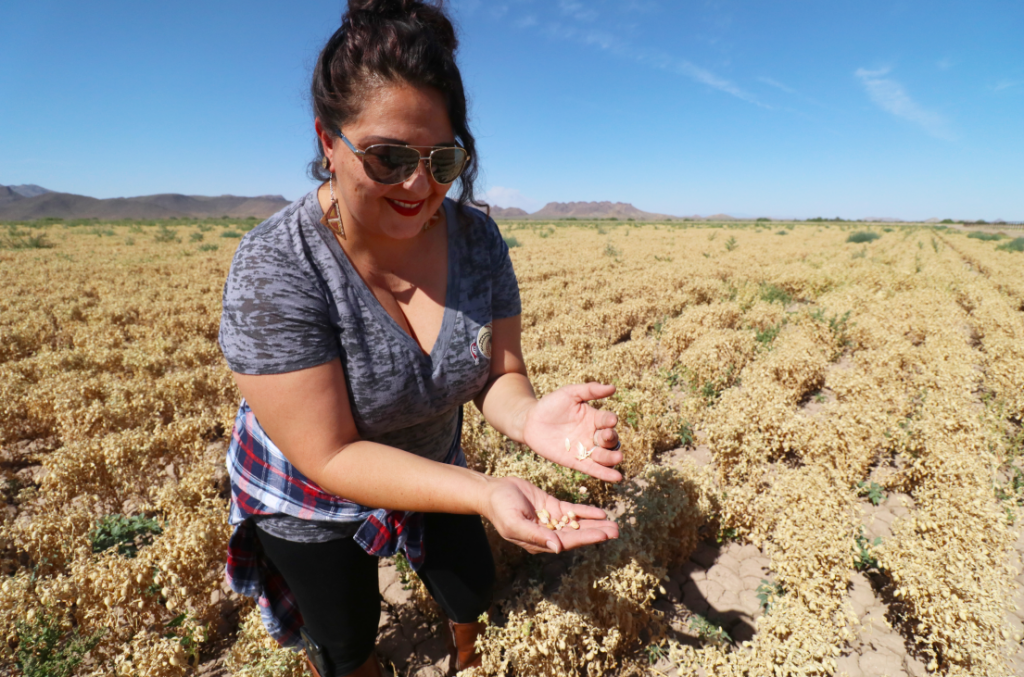Velvet Button’s parents, Ramona and Terry, started farming on a 10-acre allotment on the Gila River Indian Community Reservation south of Phoenix more than four decades ago. Today, the family farms 4,000 acres of alfalfa, Bermuda hay and four types of traditional beans. Ramona and Terry were inducted into the Arizona Farming and Ranching Hall of Fame in 2017, and at least 100 chefs from coast to coast are cooking or baking with their products.
“We’re bringing our traditional food crops to the modern table,” Velvet told us recently on a tour of Ramona Farms. Here are some highlights from our interview and tour with Velvet.
How did Ramona Farms start growing traditional crops?
My mom started growing barley with an allotment of leased land from her mother in 1974.
One day in the late 1970s Mom was cleaning out my grandpa’s old adobe house and found a trunk holding a glass pickle jar of tepary bean seeds. She started with those heirloom seeds from my grandfather, and we’ve been growing traditional crops as a side project ever since.

Velvet Button of Ramona Farms in Arizona shows off organic garbanzo beans. The farm within the Gila River Indian Community has also brought back traditional beans grown from heirloom seeds from her grandfather.
When we were kiddos, our parents would sell our beans to mom-and-pop shops and smaller grocers in rural areas. Traveling down those dusty and far roads was our family time. The fields with Mom were our daycare. When I was little, I kept seeds in my jewelry box.
What was the response to the reintroduction of tepary beans?
Mom spoke O’odham, so she could communicate with the elders. Some elders hadn’t seen these beans for many, many years. One elder said, “You are bringing my mother home again.”
What else are you growing?
We grow alfalfa and bermuda grass for horses.
We’ve also added new crops, like organic garbanzo beans (seen in the picture), which are called “Kalvash.” Garbanzo beans were introduced to the area in the 1680s by Padre Kino (a Spanish Jesuit missionary).
We have 240 acres of organic food crops.
Centuries ago ancestors of the Gila River Indian Community built 500 miles of large canals for farming. Toward the end of the 19th century the community faced mass famine and starvation when farmers diverted water upstream. The community won back its high priority water rights and now is modernizing its water system and conserving Colorado River water. What does water mean to you?
Water is everything. We rejoice that our leaders have secured our water and the future of agriculture here at the Gila River Indian Community.
The canal projects are very important, but it’s bittersweet. There are mesquite trees along the canals that have been here for over a hundred years. But we will be losing them. We hope to make use of the wood for stoves and cooking. (As the community improves water efficiency by lining earthen canals that were losing as much as 70 percent of their water, the trees will lose access to the water that previously seeped into the ground.) This Arizona farm combines tribal traditions with modern practices to increase the resilience of its operation. Here's how: Share on X
How has Ramona Farms evolved to conserve water?
We laser-level the land and we maintain our concrete field ditches and gates, preventing leaks and water loss through ditch breaks.
We decide what to grow according to the water available. The tepary bean that our ancestors grew and we re-introduced is the most drought-adapted species of bean in the world.
What do you cook with tepary beans?
You can use them in everything. A frittata, tacos, desserts. The black tepary bean can be used to make an amazing vegan chocolate mousse. They are so versatile. The white tepary is sweet and buttery, the crown tepary nutty and earthy, and the black tepary very bold so it’s almost chocolatey.
You describe your work as “healing the food system.” Can you explain?
My mom was a professional nurse and started to see a decline in health on the reservation as people moved away from traditional foods and experienced serious health issues like diabetes and heart disease. She started going into schools to share stories about how our ancestors used to farm and talked about the ways of our ancestors to promote healthy eating.
Today we also give presentations at health food fairs, museums and universities.
We focus on health and how our ancestors ate before colonization, with less grease and oil and more plant-based diets instead of packaged food. We hope our kiddos take up this healthier way of eating.
Can you share your favorite recipe with us?
Southwest Tepary Summer Salad
Clean and rinse 1 lb. of brown and/or white tepary beans.
Cook beans in a crockpot with 4 quarts of filtered water on high for 8 hours. (Overnight soaking of beans when using a crockpot is optional).
Drain and cool.
In a large bowl, add:
3-4 oz. olive oil
1/4 tsp ground cumin
1/2 tsp ground Mexican oregano
1/4 tsp ground celery seed
1/8 tsp ground coriander
1/2 tsp ancho chili powder
2 tbsp chopped cilantro
3 garlic cloves minced
sea salt and cracked pepper to taste
Cut corn off one corn cob and toast in a hot skillet 2 to 3 minutes.
Small chop vegetables: I use gray and yellow squash, asparagus, green onion, 1/2 sweet onion, diced poblano pepper, 2 roasted Anaheim peppers and heirloom grape tomatoes.










One Comment
I’m from Dist 6, I’d like to know do you still make the Roasted Corn? I get it at Dist 5 Store, we never seem to get it here in 6.. It’s been awhile, but I Love all your products you sell..